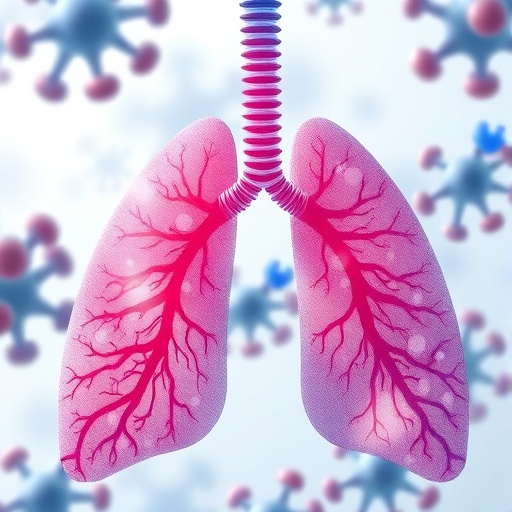
In the relentless pursuit of more effective cancer treatments, the intricate mechanisms governing cell division have consistently held the spotlight. Among the myriad of molecular players, cyclin-dependent kinases 1 and 2 (CDK1 and CDK2) are emerging as pivotal regulators, not only orchestrating cell cycle progression but also influencing tumorigenic processes. Recent research spearheaded by Gupta, Saeed, Bishoyi, and colleagues delves deeply into the dualistic role of these kinases, revealing insights that could reshape cancer therapy paradigms and offer new therapeutic targets for a variety of malignancies.
The cell cycle, a fundamental process through which cells grow and divide, is tightly regulated by a series of checkpoints ensuring genomic stability and proper replication. CDKs, particularly CDK1 and CDK2, serve as crucial gatekeepers, coordinating transitions between distinct phases of the cycle. Any dysregulation in their activity has been closely linked to aberrant cell proliferation—a hallmark of cancer. Understanding how these kinases function and malfunction in neoplastic contexts is vital to devising strategies that can specifically stunt tumor growth without harming normal tissues.
CDK1, often dubbed the master regulator of mitosis, spearheads the final preparation of cells for division. By forming complexes with specific cyclins, CDK1 drives the critical transition from the G2 phase to mitosis, ensuring chromosomes are accurately segregated and cell division proceeds unimpeded. Meanwhile, CDK2 predominantly regulates the G1 to S phase progression, facilitating DNA synthesis. The interplay between these kinases orchestrates a harmonious cell cycle; however, their perturbations contribute significantly to oncogenic transformation.
.adsslot_mVKtYH3la0{width:728px !important;height:90px !important;}
@media(max-width:1199px){ .adsslot_mVKtYH3la0{width:468px !important;height:60px !important;}
}
@media(max-width:767px){ .adsslot_mVKtYH3la0{width:320px !important;height:50px !important;}
}
ADVERTISEMENT
In cancer cells, mutations and overexpression of CDK1 and CDK2 often override normal cell cycle checkpoints, resulting in uncontrolled proliferation and survival despite genomic insults. This phenomenon fosters an environment ripe for tumorigenesis and resistance to conventional therapies like chemotherapy and radiotherapy. Gupta et al. highlight that the aberrant activation of CDK1/CDK2 not only affects cell cycle dynamics but also intersects with DNA damage response pathways, metabolic reprogramming, and apoptotic evasion, collectively enhancing tumor aggressiveness.
One of the groundbreaking revelations from this research is the nuanced understanding of how CDK1 and CDK2 can act as both facilitators and potential suppressors of cancer progression, depending on cellular context. While hyperactivity encourages unchecked division, complete inhibition can impair cellular viability and trigger synthetic lethality in cancer cells harboring specific genetic backgrounds. This dual role underscores the complexity in targeting these kinases therapeutically and necessitates precise modulation rather than broad-spectrum inhibition.
The therapeutic implications of these findings are profound. CDK inhibitors have been explored over the past decade, but many have struggled with selectivity and adverse side effects due to the ubiquitous nature of these kinases in normal physiology. The study by Gupta and colleagues advocates for novel strategies that exploit the distinct structural and functional differences between CDK1 and CDK2 or their interaction partners, thereby achieving a more targeted anti-cancer effect.
Moreover, combining CDK inhibition with other treatment modalities could potentiate efficacy. For example, by sensitizing tumor cells to DNA damaging agents or immune checkpoint inhibitors, modulating CDK1 and CDK2 activity emerges as a promising combinatorial therapeutic approach. This synergy has the potential to overcome resistance mechanisms that frequently plague cancer therapies, offering hope for durable responses in refractory tumors.
The authors also emphasize the importance of biomarker development to predict which tumors are most likely to respond to CDK-targeted treatments. Given the heterogeneity among cancers, not all will exhibit the same dependency on CDK1 or CDK2 activity. Genomic profiling and functional assays could enable personalized treatment regimens, optimizing therapeutic windows and minimizing toxicity.
Beyond direct enzyme inhibition, the research touches upon the regulation of CDK1 and CDK2 via post-translational modifications and interactions with other cellular pathways. Understanding these regulatory networks can uncover indirect intervention points, expanding the arsenal against tumor growth and progression. This system-level insight aligns with modern oncology’s shift toward integrated, multi-target strategies.
Importantly, the study by Gupta et al. sheds light on the structural biology of CDK1 and CDK2, revealing subtle differences in their active sites and regulatory domains. Such structural nuances offer avenues for the design of highly specific inhibitors, which could selectively disrupt pathological kinase activity while sparing normal cellular functions. This precision medicine approach is aligned with the broader goals of minimizing adverse effects in cancer therapy.
The research also draws attention to the potential role of CDK1 and CDK2 in cancer stem cell biology. These subpopulations within tumors are notorious for driving relapse and metastasis due to their stem-like properties and resistance to conventional drugs. Targeting CDK-driven pathways in these cells could curtail tumor recurrence and improve long-term patient outcomes.
Another compelling aspect discussed involves the temporal dynamics of CDK1 and CDK2 activity during cancer progression. The kinases’ activation patterns can vary across different tumor stages and microenvironmental conditions, suggesting that therapeutic timing could be crucial. Intermittent or stage-specific CDK modulation might confer maximal efficacy, a concept warranting further clinical investigation.
Furthermore, the effects of CDK dysregulation extend into immune evasion mechanisms. Altered CDK1/CDK2 activity can influence the expression of immune modulatory molecules on cancer cells, thereby impacting tumor-immune interactions. This intersection opens a new frontier in immuno-oncology where CDK targeting could synergize with immune checkpoint therapies to amplify anti-tumor immunity.
In conclusion, the comprehensive study led by Gupta and colleagues amplifies our understanding of CDK1 and CDK2 beyond their canonical roles, portraying them as multifaceted agents in cancer biology. Their findings reinforce the promise these kinases hold as therapeutic targets, offering a blueprint for next-generation cancer treatments that are both efficacious and finely tuned to individual tumor biology. As the oncology field pivots toward increasingly personalized and mechanism-based interventions, unraveling the complexities of cell cycle kinases like CDK1 and CDK2 remains a critical frontier.
The road ahead involves translating these molecular insights into clinical realities through the development of selective inhibitors, combinatorial regimens, predictive biomarkers, and thoughtful dosing strategies. Ultimately, mastering the art of cell cycle modulation could transform cancer therapy, turning what was once a uniformly fatal diagnosis into a manageable condition. The work of Gupta et al. stands as a milestone in this journey, reminding us that within the cycles of cells reside the keys to unlocking cancer’s vulnerabilities.
Subject of Research: The role of cyclin-dependent kinases CDK1 and CDK2 in cell cycle regulation and their implications in tumorigenesis and cancer therapy.
Article Title: From cell cycle control to cancer therapy: exploring the role of CDK1 and CDK2 in tumorigenesis.
Article References:
Gupta, J., Saeed, B.I., Bishoyi, A.K. et al. From cell cycle control to cancer therapy: exploring the role of CDK1 and CDK2 in tumorigenesis. Med Oncol 42, 422 (2025). https://doi.org/10.1007/s12032-025-02973-1
Image Credits: AI Generated
Tags: cancer treatment breakthroughsCDK1 and CDK2 in cancer therapycell cycle regulation and genomic stabilitycyclin-dependent kinases role in cell cycledysregulation of CDKs in cancerinsights into cancer therapy paradigmsmitosis regulation by CDK1molecular mechanisms of cell divisionresearch on cancer treatment innovationsstrategies for tumor growth inhibitiontherapeutic targets for malignanciestumorigenic processes and CDKs





